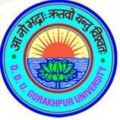Contact Information
-
location_on
Civil Lines, Gorakhpur, Uttar Pradesh 273009, India
-
call
(0551) 2201577, 2340363, 2203098
-
mail_outline
(0551) 2340363, 2330767
-
email
- web_asset
Approved By: UGC NCTE
B.A. (Ancient History)
|
Duration: 3 Years |
Eligibility: 10+2 |
Course Details:-
Note:- There shall be seven papers, two in the first, two in the second, and three in the third year.
| Part-1 | |
|
Paper I : |
Political history of India (from 600 BC to 550 AD) |
|
Paper II : |
Ancient Civilizations : |
|
|
Western Asia : Sumerian, Babylonian, Assyrian. |
|
|
Egyptian : Pyramid Age, Middle Age, Imperial Age. |
|
|
Aegean and Greek : Minoan, Mycenaean, Classical. |
|
|
Iranian : Pre-Achaemenian. |
|
|
Chinese : Shang Dynasty. |
|
|
Harrapan : Rise, Extent, Chronology, Authors, Main Characteristics. |
|
Part-2 |
|
|
Paper I : |
Political History of India (550 A.D. to 1200 A.D.) |
|
Paper II : |
Ancient Indian Society and State |
|
|
Society: Varnasrama, Jatis, Family Structure, Education, Marriage, Position of Women, Position of Slaves, Guilds. |
|
|
State: Origin, Types, Monarchy, Ministry, Republics, Taxation. |
|
Part-3 |
|
|
Paper I : |
Elements of Numismatics and Palaeography. |
|
|
A. Numismatics |
|
|
Origin and evolution of coinage in India. |
|
|
Characteristics of Punch-Marked Coins. |
|
|
Indo-Greek coins with special reference to the coins of Demetrius, Eucratides, Agathocles and Menander. |
|
|
Indo-Scythian and Indo-Parthian coins with special reference to the coins of Maues, Azes, Azilises and Gondophernes. |
|
|
Local and Tribal coins with special reference to Kaushambi and Yaudheya coins. |
|
|
Kushan coins with special reference to the coins of Wima Kadphises and Kanishka. |
|
|
Western Kshatrapa and Satavahana coins with special reference to the coins of Gautamiputra Satakarni. |
|
|
Gupta coins with special reference to the Chandragupta-Kumar Devi type, coins of Samudragupta, Kach and Chandragupta II. |
|
Note : Emphasis shall be given on the identification and description of coins. |
|
|
|
B. Palaeography |
|
|
Antiquity of the art of writing in India. |
|
|
Inscriptions of the Shunga and the contemporary dynasties. |
|
|
Kushan inscriptions. |
|
|
Gupta inscriptions. |
|
Paper II : |
Ancient Indian Art and Architecture |
|
|
Paintings : Prehistoric, Ajanta |
|
|
Sculptures : Indus Valley, Mauryan, Sunga, Kushan, Gupta, Early Medieval, Special studies of Gandhara, Mathura and Saranath Schools of Art. |
|
|
Architecture : Harappan Architecture, Origin and development of Stupa Architecture, Bharahut, Sanchi, Amaravati stupa, Buddhist cave Architecture, Chaityagrihas and Viharas, both Mahayana and Hinayana, Origin and Development of Temple Architecture. Gupta Temples, Mahabalipuram, Kailash Temple at Ellora, Development of Temple Architecture in Northern India : Khajuraho (Kandariya Mahadeva) Orissa (Lingaraja and Sun tample of Konark). Development of temple architecture in South India : Chalukya, Pallava, Chola, Classifications of Hindu Temples |
|
Paper III: |
Ancient Indian Religion |
|
|
Introduction : Change and Continuity, Nature of Indian Religion. |
|
Buddhism and Jainism : |
|
|
|
Origin and Development of Buddhism, Life and teachings of Gautama Buddha, The four Noble Truths, Pratitya-samutpada and Nirvana, Origin and Development of Mahayana and its relation to Hinayana, Philosophy of Shunyavada, Jain Anekantvada, Liberation, Schism in Jainism, Digambar and Shvetambar. |
|
Shaivism, Vaishnavism, Shaktism and other minor sects |
|
|
Shaiva : |
Origin and antiquity, Rudra-shiva in the Rigveda, Shiva in Vedic literature, |
|
Pashupata School : |
Origin Diffusion and Philosophy, South Indian Shaiva tradition, Vaishnava Pancharatra and Sattvata, history and philosophy. Shakti cult and minor sects of Hinduism. |

